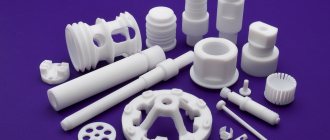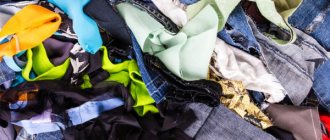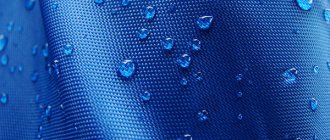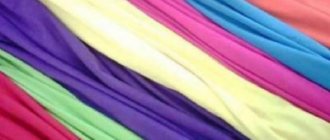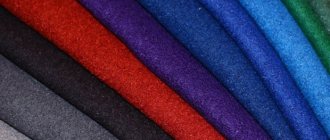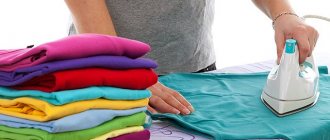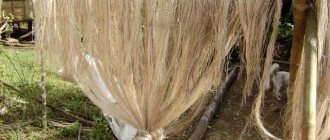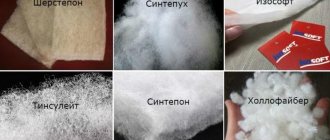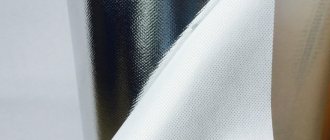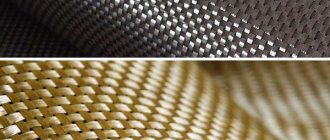Polyurethane compounds
Man-made fibers are in demand in the textile market. Several thousand types of them are known in industry. They are used for the manufacture of workwear and sports suits. Polyurethane threads have mechanical properties characteristic of rubber:
- high elasticity;
- reversible deformation.
Fabrics made from polyurethane raw materials are elastic, abrasion-resistant, elastic, and wrinkle-resistant. Fibers are rarely used in their pure form. They have found application in the textile industry as gimp threads. Their disadvantage is low thermal stability. At a temperature of +120 ℃, strength decreases.
Examples of man-made polyurethane fibers:
- elastane;
- spandex;
- neolan.
Polyurethane fibers
In terms of mechanical properties, polyurethane fibers are in many ways similar to rubber threads, because capable of highly elastic, reversible deformations. Such fibers give textile materials high elasticity, abrasion resistance, resilience, dimensional stability, and wrinkle resistance. They are rarely used in their pure form. Their most common use in fabric is as frame threads around which other threads are wound. The disadvantage of such fibers is low heat resistance. Already at 120 C, polyurethane fibers in a stretched state significantly lose their strength.
The main representatives of polyurethane fibers are trade names such as elastane, lycra, spandex, neolan, etc.
Polyamide threads
Plant and animal polyamide fibers are abrasion resistant. They have high dimensional stability. Their disadvantage is their low resistance to light and sweating. When exposed to sunlight, polyamide fibers turn yellow and become brittle.
Low hygroscopicity and a high probability of being subject to strong pilling are a feature of the threads. To improve performance properties, stabilizers are used in chemistry. In industry, polyamide fibers are added to cotton, wool, and viscose.
Finished textile products have good hygienic and mechanical properties. Raw materials can be in knitwear, hosiery, sewing thread and haberdashery. The polyamide type includes nylon, nylon, meryl, enanth.
Types and properties
General characteristics and advantages of synthetic fibers and fabrics of any kind:
- strength;
- resistance to bacteria and microorganisms;
- wear resistance;
- crease resistance.
The disadvantages are that the fibers do not absorb water well and are highly electrified.
The type and name depend on which product was used as the original (the prefix poly- is added to its name). Fabrics made from such fibers have different trade names (often each country has its own). All of them are divided into two large groups:
- heterochain. Macromolecules contain atoms of carbon and other elements. These include polyamide, polyurethane and polyester fibers;
- carbon chain. Macromolecules contain only carbon atoms. All other synthetic fibers.
Polyamide
Tensile strength, resistant to abrasion and repeated bending, not exposed to many chemicals, low temperatures, mold, bacteria. They have low heat and light resistance. Common trade names: nylon, nylon, anide.
Polyurethane
Widely known spandex, lycra, neolan. The main advantage is a high degree of elasticity without loss of strength characteristics. Abrasion resistant. Elastic, elastic and resistant to chemical reagents, the fiber has a significant drawback - low heat resistance.
Polyvinyl alcohol
They are durable and resistant to abrasion and microorganisms, light, acids and alkalis. Trade names: vinol, kuralon, mtilan. A distinctive feature of vinol is its high hygroscopicity.
Polyester (polyester)
Lavsan. Advantages: elasticity, heat resistance, low thermal conductivity and low degree of shrinkage. Disadvantages: it is destroyed by the action of acids and alkalis, it is hard, does not absorb water well and is highly electrified.
Polyacrylonitrile
They have less abrasion resistance than polyamide and polyester. They are resistant to microorganisms (and moths), have dimensional stability, and products made from them practically do not wrinkle. In appearance they are very reminiscent of natural wool. The most famous are nitron and acrylan.
Polyolefin
The raw materials for their production are polyethylene and polypropylene. Very light, durable and resistant to wear, chemicals and microorganisms. They have low hygroscopicity and are not resistant to temperature. Even at 50-60 degrees, products made from them exhibit significant shrinkage. Production costs are minimal.
Polyester compounds
Polyester threads have increased heat resistance, exceeding the values of long and short fibers. Due to good elasticity and high abrasion resistance, the raw material is widely used in industry. Fabrics made from polyester threads hold their shape, do not require ironing, and do not wrinkle. They are characterized by high physical and mechanical properties.
Disadvantages of the polyester type:
- tendency to peel;
- electrification;
- slight hygroscopicity;
- excessive rigidity.
To eliminate the disadvantages, the feedstock is modified. Polyester fibers are combined with cotton and wool. In combination with viscose threads, dress, shirt, coat fabrics, and faux fur are produced.
Modification of raw materials helps eliminate creasing. At the same time, abrasion resistance increases. The hygienic properties characteristic of primary raw materials are preserved after processing.
List of polyester threads:
- polyester;
- lavsan;
- terylene.
Synthetic fibers
Category: Clothing
Synthetic fibers are produced from polymer materials. The general advantages of synthetic fibers are high strength, resistance to abrasion and microorganisms, and wrinkle resistance. The main disadvantage is low hygroscopicity and electrification.
Polyamide fibers - nylon, anide, enant, nylon - are distinguished by high tensile strength, resistance to abrasion and repeated bending, have high chemical resistance, frost resistance, and resistance to the action of microorganisms. Their main disadvantages are low hygroscopicity, heat resistance and light resistance, and high electrification. As a result of rapid “aging”, they turn yellow, become brittle and hard. Polyamide fibers and threads are widely used in the production of household and technical products.
Polyester fibers - lavsan - are destroyed by the action of acids and alkalis, the hygroscopicity is 0.4%, therefore it is not used in its pure form for the production of household fabrics. It is characterized by high heat resistance, low shrinkage, low thermal conductivity and high elasticity. The disadvantages of the fiber are its increased rigidity, the ability to form pilling on the surface of products, low hygroscopicity and strong electrification. Lavsan is widely used in the production of fabrics, knitted and non-woven fabrics for household use in a mixture with wool, cotton, flax and viscose fiber, which gives the products increased abrasion resistance, elasticity and dimensional stability. In addition, the fiber is used in medicine to make surgical sutures and blood vessels.
Polyacrylonitrile fibers - nitron, dralon, dolan, orlon - resemble wool in appearance. Products made from it, even after washing, have high dimensional stability and wrinkle resistance. They are resistant to moths and microorganisms, and are highly resistant to nuclear radiation. In terms of abrasion resistance, nitron is inferior to polyamide and polyester fibers. It is used in the production of outer knitwear, fabrics, as well as artificial fur, carpets, blankets and fabrics.
Polyvinyl alcohol fibers - vinol, ralon - have high strength and resistance to abrasion and bending, exposure to light, microorganisms, sweat, and various reagents (acids, alkalis, oxidizing agents, petroleum products). Vinol differs from all synthetic fibers in its increased hygroscopicity, which makes it possible to use it in the production of fabrics for underwear and outerwear. Staple (short) polyvinyl alcohol fibers are used in pure form or mixed with cotton, wool, flax or chemical fibers to produce fabrics, knitwear, felt, felt, canvas, tarpaulins, and filter materials.
Polyurethane fibers - spandex, lycra - are highly elastic: they can be stretched many times and increase in length by 5-8 times. They have high elasticity, strength, wrinkle resistance, resistance to abrasion (20 times more than that of a rubber thread), to light weather and chemical reagents, but low hygroscopicity and heat resistance: at temperatures above 150°C they turn yellow and become rigid. These fibers are used to produce elastic fabrics and knitted fabrics for outerwear, women's toiletries, sportswear, and hosiery.
Polyvinyl chloride fibers - chlorine - are resistant to wear and chemical agents, but at the same time they absorb little moisture and are not resistant to light and high temperatures: at 90~100°C the fibers “shrink” and soften. Used in the production of filter fabrics, fishing nets, knitted medical underwear.
Polyolefin fibers are obtained from polyethylene and polypropylene. They are cheaper and lighter than other synthetic fibers, have high strength, resistance to chemicals, microorganisms, wear and repeated bending. Disadvantages: low hygroscopicity (0.02%), significant electrification, instability to high temperatures (at 50-60 ° C - significant shrinkage). Mainly used for the manufacture of technical materials, carpets, raincoat fabrics, etc.
Polyacrylonitrile components
Polyacrylonitrile components have mechanical properties like artificial wool: strength, high light fastness, heat resistance. The product, made from polyacrylonitrile threads, holds its shape well. Disadvantages of the type:
- low hygroscopicity;
- risk of pill formation;
- electrification;
- rigidity.
To eliminate the shortcomings, modifications are carried out. In textile factories, the technique is used when sewing outerwear. Experts combine polyacrylonitrile threads with wool and faux fur. The group includes the following fibers:
- acrylic;
- nitron;
- Cashmilon.
Fiber classification
Fiber classification:
- natural - fibers of plant origin (cotton, flax - polysaccharides (carbohydrates) having the composition (C6 H10O5)x) and animal origin (wool, silk - protein substances consisting of long polypeptide chains).
- chemical , which are divided into artificial fibers and synthetic fibers. Artificial fibers are obtained from chemical processing products of natural polymers (cellulose), for example, viscose, copper-ammonia, acetate fiber. Synthetic fibers are obtained by chemical processing of synthetic polymers. For example, nylon and nylon (polyamide fibers), lavsan (polyester fibers).
Polyolefin category
This group includes polypropylene and polyethylene threads. They are characterized by low density and lightness, zero hygroscopicity. Due to the latter property, the fibers do not sink in water, but have high thermal insulation. Their disadvantage is their low heat resistance - +115 ℃. In response to its leveling, a modification is made.
The optimal solution is to create a two-layer material, in which the bottom layer is made of polyolefin threads, and the top layer is made of hygroscopic cellulose raw materials. This technology prevents the bottom layer from getting wet. Moisture is removed into the hygroscopic top layer.
This modification is effective for sewing underwear, stockings, socks, tracksuits and other products with high hygienic characteristics. The polyolefin group includes:
- found;
- herculon;
- Ulstren;
- meraclon.
Polyethylene threads are used for technical purposes. The subcategory includes tekmilon, dyneema, spectrum.
